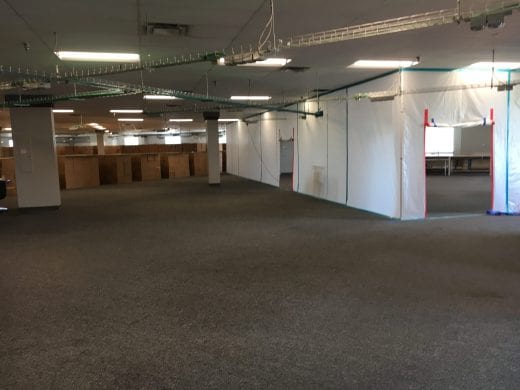A few weeks ago we talked about what happened to the wet library books after the fire in Hale Library, but there were also over a million books in the library that suffered smoke damage and require treatment.
The soot from the smoke damaged every inch of the library, and it has proven very difficult to remove from surfaces. A combination of the smoke, water, heat, and non-climate controlled building left most surfaces stained. Typically soot can be wiped away, but in this case, it is almost baked on.
This resistant soot is an anomaly that Belfor, an international disaster relief organization, has not experienced before. Because this is such a strange occurrence, we sent a few books from different parts of the library to the preservationists at the Library of Congress where they will be tested and researched.

“This soot was different from what I typically dealt with in the past because [it] causes a stain,” Kirk Lively, director of technical services at Belfor, said. “It’s not something that you wipe your finger through and you come up with a black smudge on your finger. It’s actually stained onto the surfaces.”
While we wait to hear from the Library of Congress, we continue to move books out of Hale Library over to Executive Court, a process Belfor has been working on since May 25.
K-State leased Executive Court, an office space near the airport that was most recently occupied by the College of Architecture, Planning and Design during the renovation of their Seaton Hall Complex. As of now, books from rooms 117 and 222 have been moved to Executive Court as well as most of 3rd and 4th floors. We estimate 500,000 books are currently at Executive Court waiting to be cleaned.

To clean a soot-covered book, a HEPA vacuum is used on the book’s exterior to remove most of the dirt and soot. Next, the cover, the back, and the spine of the book are wiped down with a dry chemical sponge. After the outside is clean, the book is opened and the fore edge of the pages is fanned in both directions and wiped down. It takes about 20 minutes to complete this process on a box that holds 12 to 15 books.
Kay Rieder, Belfor project manager, demonstrates how smoke damaged books are cleaned.
After they go through this manual cleaning process, all of the books will go into an ozone chamber in order to neutralize the smell and draw out the carbon. Belfor has built two ozone containment centers in Executive Court.

After the books are out of the ozone chamber, they go through a “white glove” quality control check. If any soot comes off the book or a smell still lingers from the fire, that book goes through the cleaning process again. Ozoning books can accelerate deterioration of items, so they will not ozone a book more than needed.

The cleaning process of some of the books has begun, but the crew cannot begin cleaning them in earnest until more warehouse space is acquired to store the clean materials. It is important not to put clean books near the carbon-covered books because the clean books would absorb those chemicals again.

One of the challenges with Executive Court is the inability to move books on pallets, because they don’t fit through the doorways, which slows down the cleaning process considerably. Pallets allow dozens of books to be moved at the same time but instead the boxes are managed by hand and small carts.
Currently, the few hundred boxes that have been cleaned were moved to the Library Annex. The annex is an offsite location near Executive Court that holds part of the Libraries’ collection. Patrons are able to request books from the annex, and then they are delivered to an on-campus library help desk.
After the books are cleaned, some of the books will be ingested into the annex and will be available for check out upon request. The annex is unable to hold the entire library collection, so hundreds of thousands of additional books will be sent to additional warehouse space, once it is acquired.
At Executive Court, boxes are stacked seven boxes high and fill the entire building.
The Libraries have received many questions as to why we don’t claim the books as a loss to insurance. For us, its not just about how much it would cost to replace them.
“Many of our books and other materials are out of print,” Roberta Johnson, director of administrative and IT services, said. “K-State’s resources are the result of years of collecting and carefully managing materials that provide the most relevant information to the faculty, staff and students.”
Not only are some of the books out of print, but it would take an exorbitant amount of time for the acquisitions and collection development department to search for and purchase the material. It would be a major undertaking to replace approximately 1.2 million volumes.
There is no set time frame for the books to be cleaned. As of right now, Belfor estimates it could take between six to twelve months.